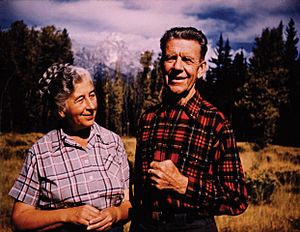Margaret Murie facts for kids
Quick facts for kids
Margaret Murie
|
|
|---|---|

Mardy Murie and Olaus at their home, Grand Tetons, 1953
|
|
| Born | Margaret Thomas August 18, 1902 Seattle, Washington, U.S. |
| Died | October 19, 2003 (aged 101) Moose, Wyoming, U.S. |
| Pen name | Mardy Murie |
| Occupation | Author, ecologist, and environmentalist |
| Nationality | American |
| Genre | Memoir |
| Subject | Conservation, wilderness preservation |
| Notable works | Two in the Far North, Wapiti Wilderness |
| Notable awards | Presidential Medal of Freedom |
| Spouse | Olaus Murie |
| Relatives | See Murie family article, people |
Margaret Thomas "Mardy" Murie (born August 18, 1902 – died October 19, 2003) was an amazing American naturalist, writer, and adventurer. She was also a strong voice for protecting nature. People called her the "Grandmother of the Conservation Movement."
Mardy Murie helped create the Arctic National Wildlife Refuge. This is a huge protected area in Alaska. She also played a big part in passing the Wilderness Act. This law helps keep wild places safe across the United States. For her important work, she received many awards, including the Presidential Medal of Freedom. This is the highest award a civilian can get in the U.S.
Contents
Mardy Murie's Early Life
Margaret Thomas was born in Seattle, Washington, on August 28, 1902. When she was nine, her family moved to Fairbanks, Alaska. She went to college and became the first woman to graduate from the Alaska Agricultural College. This school is now known as the University of Alaska Fairbanks. She earned her degree in business in 1924.
In Fairbanks, she met Olaus Murie. They got married in 1924 in Anvik, Alaska.
Adventures in the Wild
From 1927 on, Mardy and Olaus lived in Jackson, Wyoming. Olaus studied animals, especially the elk. Mardy worked right alongside him in the field. They studied elk, sheep, and many other animals. They explored the Greater Yellowstone Ecosystem together.
The Muries would camp for weeks in the wild Jackson Hole valley. Olaus wanted to find out why the elk population was shrinking. For almost 40 years, they went on many trips into the backcountry. They even took their three children with them when they were babies.
After World War II, Mardy wanted to live closer to nature. So, they bought a dude ranch. This ranch became a place where people talked about protecting wild areas. Olaus and Mardy worked for the Wilderness Society. They helped write ideas for laws to protect places like Jackson Hole National Monument.
After Olaus passed away, Mardy kept working to protect nature. She traveled to Alaska, Tanzania, and New Zealand. She looked at wild areas and worked to keep them safe from harm.
Books and Stories
Mardy Murie wrote several books about her life and adventures. Her book, Two in the Far North, came out in 1962. It tells the story of her early life, her marriage, and her research trips in Alaska.
She also wrote Island Between, published in 1977. She co-wrote Wapiti Wilderness with her husband in 1966. A movie called Arctic Dance was made about her life.
Working for Wilderness Protection
Mardy and Olaus spent their honeymoon studying birds. They traveled over 500 miles by dogsled. They also studied the caribou in the Brooks Range in Alaska. Mardy believed in protecting entire natural areas, not just small parts. This idea helped create large parks and preserves.
In 1956, Mardy and her husband started a campaign. They wanted to protect the area that is now the Arctic National Wildlife Refuge. They convinced U.S. Supreme Court Justice William O. Douglas to help them. He helped persuade President Dwight Eisenhower to set aside 8,000,000 acres (32,000 km2) as the Arctic National Wildlife Range. This area was made even bigger and renamed in 1980.
After her husband died in 1963, Mardy continued their work. She wrote letters and articles. She traveled to meetings and gave speeches. She advised groups like the Wilderness Society and the National Park Service. Mardy went back to Alaska to look at more areas for the National Park Service. She worked on the Alaska National Interest Lands Conservation Act. She spoke to Congress to support this law. It was signed in 1980 by President Carter. This law protected 104,000,000 acres (420,000 km2) of land in Alaska. It also doubled the size of the Arctic National Wildlife Refuge.
The Murie Residence in Moose, Wyoming, is a special place. It was added to the National Register of Historic Places in 1990. It is now part of the Murie Ranch Historic District. This district was named a National Historic Landmark in 2006. Today, it is home to a conservation institute named after Mardy and Olaus.
Awards and Honors
Mardy Murie received many important awards for her work.
- In 1980, she received the Audubon Medal.
- In 1983, she received the John Muir Award.
- In 1986, she received the Robert Marshall Conservation Award.
- The National Park Service made her an honorary park ranger.
- The University of Alaska gave her an honorary degree.
In 1998, President Clinton gave her the Presidential Medal of Freedom. This is a very high honor. Just before her 100th birthday in 2002, Mardy received the J.N. Ding Darling Conservationist of the Year Award. This is the highest honor from the National Wildlife Federation.
Mardy Murie passed away in Moose, Wyoming, on October 19, 2003. She was 101 years old.

